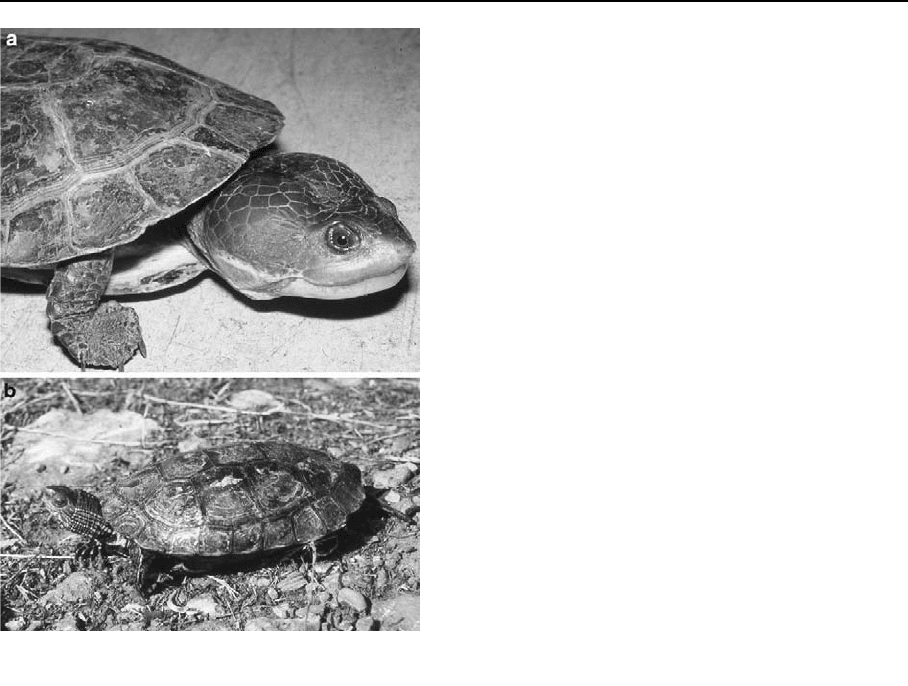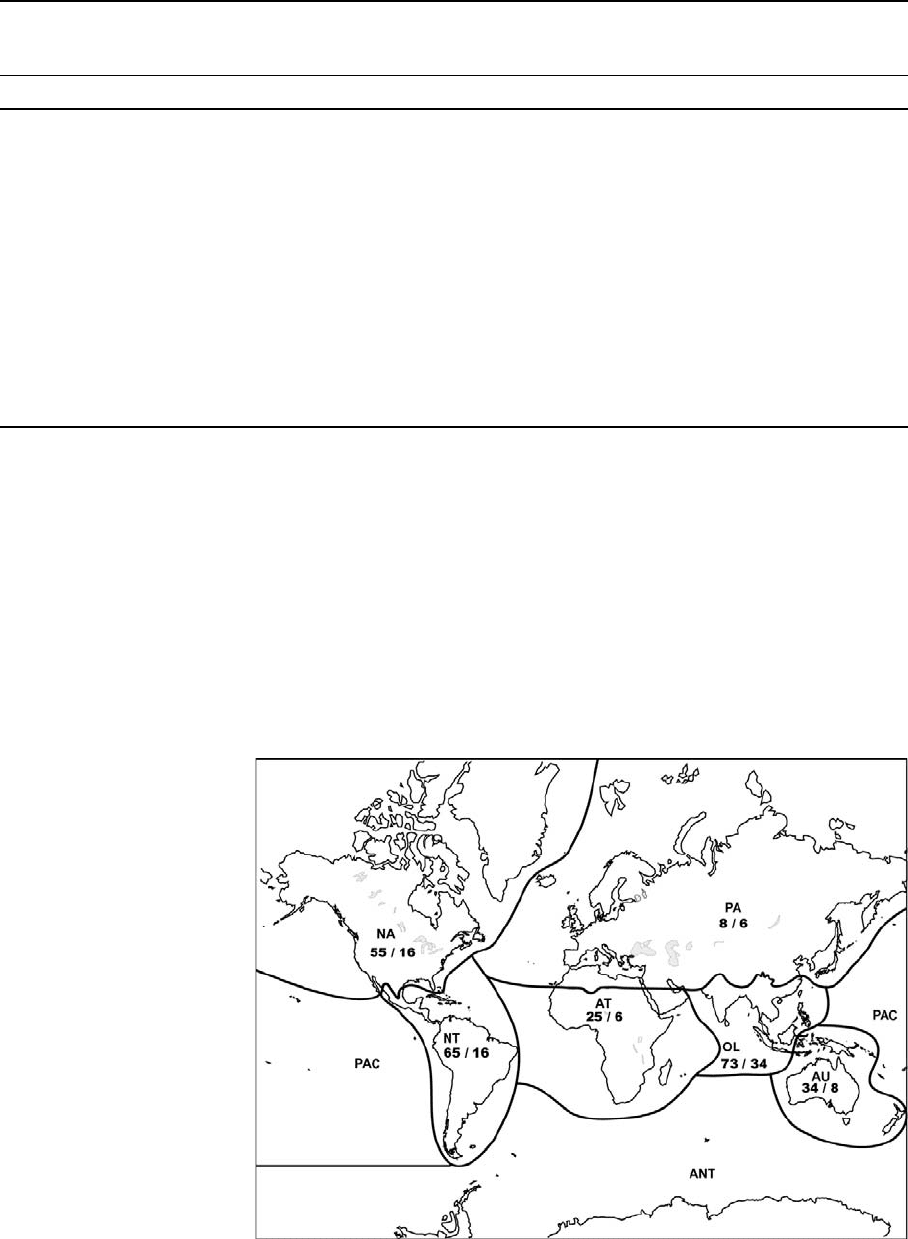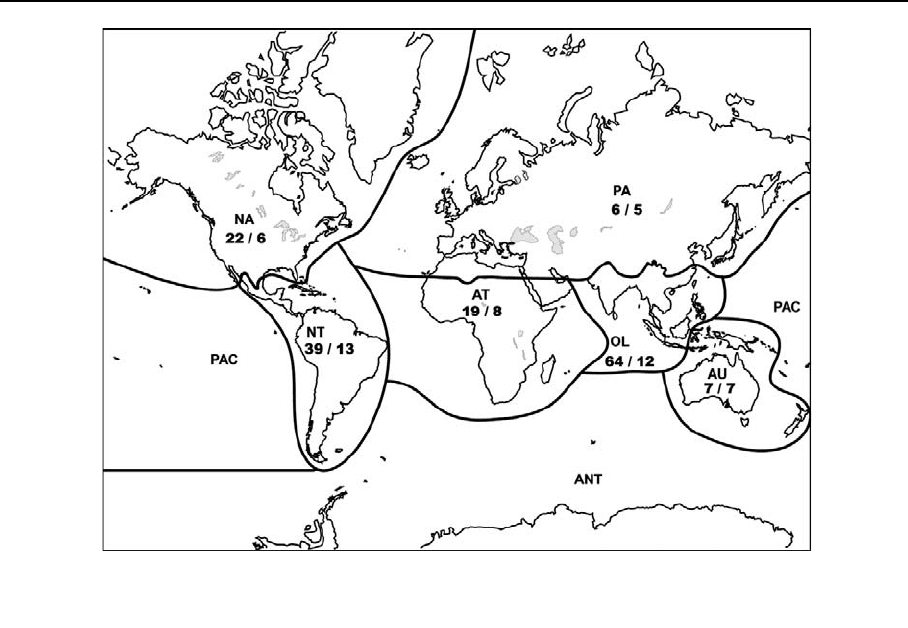Balian E.V., L?v?que C., Segers H., Martens K. (Eds.) Freshwater Animal Diversity Assessment
Подождите немного. Документ загружается.


families, i.e. Emydidae and Geoemydidae. Their
adaptation towards a more or less complete life
outside of the water seems to be a rather fast process,
because in one genus, one can recognize true fresh-
water species, amphibious or semi-aquatic species
and terrestrial turtles. This condition is especially
conspicuous in the Neartic genus Terrapene (box
turtles), family Emydidae, the e xtreme being T. coa-
huila, which is fully aquatic, and T. ornata ,whichcan
live in very dry areas. Some other species that have
adopted a rather t errestrial life, however often in
forested and damp areas, belong to the family
Geoemydidae and are encountered in South-east Asia
(Heosemys, Geoemyda, Pyxidea, Cuora), an d in
Tropical America (Rhinoclemmys). Outside these
families, turtles that regularly leave their water home
andarecomfortableonlandbelongtothegenera
Pelomedusa (Pelomedusidae ), Kinosternon, Chelo-
nia, Glyptemys and some others. These can wander
long distances, especially by night, from one swamp
to another. Most other species only leave the water
either for basking (on logs, rocks, sandy shores: e.g.
Platysternon) or for laying eggs. Table 1 gives data
on the typical environment of the extant genera of
turtles.
Many turtles are opportunistic regarding their diet,
eating any available food, whether of animal or
vegetal origin, but they usually probe potential food
items by smelling before eating. Q uite often, during
growth, there is a shift from a rather carnivorous
feeding towards a vegetarian one. Preys mainly
consist of invertebrates (e.g. insects, mollusks), or
carrion: many turtles are unable to capture adult
vertebrates, except for some specialized taxa (e.g.
Chelidae like Chelus, Trionychidae, Macrochelys)
that are capable of ambushing fishes. Vegetarian
turtles eat aquatic plants, grasses, leaves or fallen
fruits.
Species and generic diversity of freshwater turtles
A little more than 320 species of Turtles are
recognized today, depending on the taxonomy fol-
lowed (Pritchard, 1979; Ernst & Barbour, 1989;
Iverson, 1992; David, 1994; Spinks et al., 2004;
Bonin et al., 2006). A single family includes the true
terrestrial members, called Tortoises (18 genera, ca.
60 species), and two families include all the present
marine Turtles or true Turtles (6 genera, 7–8 species).
All others Chelonians are freshwater turtles and
belong to one of the other 11 families (Table 2). Three
families (Chelidae, Pelomedusidae and Podocnemid-
idae) belong to suborder Pleurodira, which is
considered to be the most primitive suborder not-
withstanding that several specialized features are
present. Pleurodira has a typical Gondwanan range,
occurring mainly in the Southern hemisphere. The
other families belong to Cryptodira; 3 families are
monotypic (Carettochelyidae, Dermatemydidae and
Platysternidae), with a limited distribution; 3 other
families include numerous species and have a wide
range, covering several biogeographical regions
(Trionychidae, and the related Emydidae and Geo-
emydidae). Finally, 2 families (Chelydridae and
Kinosternidae), with only 6 genera together, are
limited to the New World, with a mainly Nearctic
range (Vetter, 2005). Table 1 gives the list of the
genera considered in this review, with their respec-
tive number of sp ecie s.
Fig. 1 (a) Mesoclemmys nasuta (Pleurodira), (b) Mauremys
rivulata (Cryptodira)
594 Hydrobiologia (2008) 595:593–598
123

Table 1 Summary of the diversity, distribution and ecology of the extant genera of freshwater turtles
Suborder, family Genus Number of species Biogeographical region Typical environment
Pleurodira
Chelidae Chelodina 8 Australasian Rivers, swamps
Elseya 10 Australasian Rivers, swamps
Elusor 1 Australasian Rivers
Emydura 7 Australasian Rivers, swamps
Macrochelodina 5 Australasian Rivers
Pseudemydura 1 Australasian Swamps
Rheodytes 1 Australasian Rivers
Acanthochelys 4 Neotropical Small rivers, swamps
Chelus 1 Neotropical Swamps
Hydromedusa 2 Neotropical Small rivers
Mesoclemmys 10 Neotropical Rivers, swamps, ponds
Phrynops 4 Neotropical Rivers
Platemys 1 Neotropical Swamps, ponds,
Rhinemys 1 Neotropical Rivers (black waters)
Pelomedusidae Pelomedusa 1 Afrotropical (incl. Madagascar) Ponds, swamps
Pelusios 18 Afrotropical (incl. Madagascar) Lakes, quiet rivers
Podocnemididae Erymnochelys 1 Madagascar (Afrotropical) Lakes, quiet rivers
Peltocephalus 1 Neotropical Swamps, rivers
Podocnemis 6 Neotropical Rivers and tributaries
Cryptodira
Carettochelyidae Carettochelys 1 Australasian Rivers and tributaries
Chelydridae Chelydra 3 Nearctic, Neotropical Swamps, rivers
Macrochelys 1 Nearctic Lakes, quiet rivers
Dermatemydidae Dermatemys 1 Neotropical (North) Lakes, quiet rivers
Emydidae Actinemys 1 Nearctic Swamps, ponds, rivers
Chrysemys 1 Nearctic Rivers, Lakes
Clemmys 1 Nearctic Swamps, ponds, rivers
Deirochelys 1 Nearctic Swamps, rivers
Emydoidea 1 Nearctic Swamps, rivers
Emys 1 Palaearctic Swamps, ponds, rivers
Glyptemys 2 Nearctic Swamps, bogs, rivers
Graptemys 15 Nearctic Rivers, lakes
Malaclemys 1 Nearctic Brackish waters only
Pseudemys 3 Nearctic Rivers, lakes, ponds
Terrapene 6 Nearctic Swamps or terrestrial
Trachemys 15 Nearctic, Neotropical Rivers, lakes, ponds
Geoemydidae Batagur 1 Oriental Rivers and tributaries, estuaries
Callagur 1 Oriental Rivers and tributaries, lakes
Chinemys 2 Oriental, Palaearctic Rivers, swamps, ponds
Cuora 12 Oriental Rivers, swamps or terrestrial
Cyclemys 4 Oriental Rivers, swamps
Geoclemys 1 Oriental Rivers and tributaries
Geoemyda 3 Oriental Swamps or terrestrial
Hydrobiologia (2008) 595:593–598 595
123

Present distribution and main areas of endemicity
Most freshwater turtles live in the tropical and
subtropical zones, only few reach the Northern tem-
perate zone. Even in warm areas, their distribution is
quite unbalanced, and two hot spots, both of endemicity
and diversity, can be discerned in the Northern
hemisphere. One covers the Southeast of North
America (Emydidae), the other one is Southeast Asia,
more specifically the Indo-Malayan biogeographical
Table 1 continued
Suborder, family Genus Number of species Biogeographical region Typical environment
Hardella 2 Oriental Rivers, lakes
Heosemys 4 Oriental Rivers, swamps or terrestrial
Hieremys 1 Oriental Rivers, swamps
Kachuga 3 Oriental Rivers and tributaries
Leucocephalon 1 Oriental Rivers, swamps
Malayemys 2 Oriental Rivers, swamps, ponds
Mauremys 6 Oriental, Palaearctic Rivers, swamps, ponds, wadis
Melanochelys 2 Oriental Rivers, swamps or terrestrial
Morenia 2 Oriental Rivers and tributaries, swamps
Notochelys 1 Oriental Rivers, swamps
Ocadia 1 Oriental Rivers, swamps, ponds
Orlitia 1 Oriental Rivers, lakes
Pangshura 5 Oriental Rivers, swamps
Pyxidea 1 Oriental Swamps or terrestrial
Rhinoclemmys 9 Neotropical Rivers, lakes, swamps or terrestrial
Sacalia 2 Oriental Rivers, swamps
Siebenrockiella 1 Oriental Rivers, swamps
Kinosternidae Claudius 1 Neotropical (North) Swamps, quiet rivers
Kinosternon 19 Nearctic, Neotropical Swamps, quiet rivers
Staurotypus 2 Neotropical (North) Lakes, quiet rivers
Sternotherus 4 Nearctic Swamps, quiet rivers
Platysternidae Platysternon 1 Oriental Small rivers in hilly areas
Trionychidae Amyda 1 Oriental Rivers and tributaries, lakes
Apalone 3 Nearctic Rivers and tributaries, lakes
Aspideretes 4 Oriental Rivers and tributaries, lakes
Chitra 3 Oriental Rivers and tributaries
Cyclanorbis 2 Afrotropical Rivers and tributaries, lakes
Cycloderma 2 Afrotropical Rivers and tributaries, lakes
Dogania 1 Oriental Rivers and tributaries, lakes
Lissemys 2 Oriental Rivers and tributaries, lakes
Nilssonia 1 Oriental Rivers and tributaries, lakes
Oscaria 1 Oriental, Palaearctic Rivers and tributaries, lakes
Palea 1 Oriental Rivers and tributaries, lakes
Pelochelys 2 Oriental Rivers and tributaries, estuaries
Pelodiscus 1 Oriental, Palaearctic Rivers and tributaries, swamps
Rafetus 1 Palaearctic Rivers and tributaries
Trionyx 1 Afrotropical, Palaearctic Rivers and tributaries, lakes
Total N = 79 N = 257
596 Hydrobiologia (2008) 595:593–598
123

realm (Geoemydidae and Trionychidae) (Vetter &
van Dijk, 2006). The relative paucity of turtles in
the Palaearctic region, especially compared with the
Nearctic, is most probably a consequence of the
Pleistocene glaciations, in conjunction with the East-
West orientation of geographical barriers (Mediterra-
nean basin, Himalayas) preventing climate-induced
range shifts and recolonization. In the Southern hemi-
sphere, one family (Chelidae) predominates, and is
almost equally represented in South America and in
Australasia, while the Pelomedusidae is the dominant
family of freshwater turtles in Africa. Endemicity at the
regional, or even local, scale is the rule for freshwater
turtles at the genus and, especially, species level; there
are relatively few genera or species that have a range
that spans more than one region. Figure 2 gives an
arrangement of the taxa of Table 1 classified according
to biogeographical regions.
Table 2 Distribution of extant species and genera of freshwater turtles, per Biogeographical region. (number of genera in
parentheses)
PA NA NT AT OL AU PAC ANT World
Chelidae 23 (7) 33 (7) 56 (14)
Pelomedusidae 19 (2) 19 (2)
Podocnemididae 7 (2) 1 (1) 8 (3)
Carettochelyidae 1 (1) 1 (1)
Chelydridae 2 (2) 2 (1) 4 (2)
Dermatemydidae 1 (1) 1 (1)
Emydidae 1 (1) 42 (11) 6 (1) 48 (12)
Geoemydidae 3 (1) 9 (1) 57 (23) 68 (24)
Kinosternidae 12 (2) 17 (3) 26 (4)
Platysternidae 1 (1) 1 (1)
Trionychidae 4 (4) 3 (1) 5 (3) 17 (10) 26 (15)
Total 8 (6) 59 (16) 65 (16) 25 (6) 72 (34) 34 (8) 0 (0) 0 (0) 257 (79)
PA, Palaearctic region; NA, Nearctic region; NT, Neotropical region; AT, Afrotropical region; OL, Oriental region; AU, Australasian
region; PAC, Pacific region and Oceanic Islands; ANT, Antarctic region
Fig. 2 Distribution of
freshwater turtle species
and genera per
biogeographic region
(number of species /
number of genus). PA,
Palaearctic region; NA,
Nearctic region; NT,
Neotropical region, AT,
Afrotropical region; OL,
Oriental region; AU,
Australasian region; PAC,
Pacific region and oceanic
islands; ANT, Antarctic
region
Hydrobiologia (2008) 595:593–598 597
123

Human related issues
Turtles (and tortoises) are very sensitive to modifi-
cations of their environment, and are among the first
vertebrates to disappear when a habitat is destroyed.
Another threat is increasing collection, for food, for
perceived medical purposes and for the pet trade.
According to the last IUCN classification (IUCN,
2006), 159 species, or ca. 60%, of freshwater turtles
are accounted as being more or less threat ened. Data
are deficient for 10 species including 5 probable
hybrids, 1 species is at low-risk but conservation
dependant (Podocnemis expansa, a large river turtle
of South America), 11 are considered as of least
concern, 40 as vulnerable, 38 as near threatened, 36
as endangered, 20 as critically endangered, 1 as
extinct in the wild (Aspideretes nigrica ns, a large soft
shell turtle restricted to a tank in Bangladesh) and 2
as extinct (Pelusios seychellensis and Cuora yunnan-
ensis, although a specimen o f the later has recently
been observed in a market). About one third of these
threatened species are South-east Asian, China being
a major consumer of turtles. It is revealing that
among the species listed as endangered or critically
endangered there are at lea st five, resp. two species,
which were quite abundant in the pet trade no more
than twenty years ago: Chinemys reevesii, Geoemyda
spengleri, Heosemys spinosa, Pyxidea mouhotii,
Platysternon megacephalum and Cuora galbinifrons
and Cuora trifasciata, respectively), all from South-
east Asia.
Acknowledgements I thank Estelle Balian for her patience
and support, and Peter Paul van Dijk for his fruitful comments
as reviewer.
References
Bonin, F., B. Devaux & A. Dupre
´
, 2006. Turtles of the World.
Transl. Pritchard, The Johns Hopkins University Press, P.
C. H. Baltimore.
David, P., 1994. Liste des reptiles actuels du monde I.
Chelonii. Dumerilia 1: 7–127.
Ernst, C. H. & R. W. Barbour, 1989. Turtles of the world.
Washington, Smithsonian Inst. press.
IUCN, 2006. 2006 IUCN Red List of Threatened Species.
http://www.iucnredlist.org, downloaded on 6 November
2007.
Iverson, J. B., 1992. Revised Checklist with Distribution Maps
of the Turtles of the World. Richmond, Indiana, privately
printed.
Pritchard, P. C. H., 1979. Encyclopedia of Turtles. T.F.H.
Publications Co., Neptune City, New Jersey.
Spinks, P. Q., H. B. Shaffer, J. B. Iverson & W. P. McCord, 2004.
Phylogenetic hypothesis for the turtle family Geoemydidae.
Molecular Phylogenetics and Evolution 32: 164–182.
Vetter, H., 2005. Terralog, Turtles of the World, Vol. 3. Central
and South America. Frankfurt am Main and Rodgau,
Chimaira and Aqualog.
Vetter, H. & P. P. van Dijk, 2006. Terralog, Turtles of the
World, Vol. 4. East and South Asia. Frankfurt am Main
and Rodgau, Chimaira and Aqualog.
598 Hydrobiologia (2008) 595:593–598
123

FRESHWATER ANIMAL DIVERSITY ASSESSMENT
Global diversity of snakes (Serpentes; Reptilia)
in freshwater
Olivier S. G. Pauwels Æ Van Wallach Æ Patrick David
Springer Science+Business Media B.V. 2007
Abstract A list of the snake species inhabitin g
freshwaters is provided. It includes 153 species,
which represents about 5% of all known snakes.
These freshwater snakes belong to 44 genera distrib-
uted among the families Acrochordidae, Boidae,
Colubridae, Elapidae, Homalopsidae and Viperidae.
The highest diversities in freshwater snakes are found
in the Oriental (64 species) and Neotropical (39
species) Regions. Conservation actions are needed
for several overcollected species with a limited
distribution.
Keywords Snakes Serpentes Freshwater
Biodiversity
Introduction
With about 3000 species known so far, snakes are a
successful group of predatory vertebrates that occupy
a wide range of environments in tropical and
temperate areas, from deserts and mountain summits
to oceans. Many snake species live close to water and
often venture into it; probably all can swim, but only
a limited number can be consider ed strictly aquatic.
One can regard the truly aquatic snakes as those
foraging in water and which are unable to survive
without aquatic prey and frequent to constant
submersion. Subtle external anatomical characters
betray aquatic habits in freshwater snakes. These
morphological specializations include position of
nostrils on the snout top, allowing the snake to breath
at the surface without being seen by birds and other
predators; a banded pattern, useful for camouflage;
valvular nostrils; dorsolaterally oriented eyes; keeled
scales; etc. However none of these characters are
common to all freshwater snakes, and some of these
characters, like a banded pattern, are shared with
many strictly terrestrial as well as with many
exclusively marine species. Many freshwater species
Guest editors: E. V. Balian, C. Le
´
ve
ˆ
que, H. Segers, &
K. Martens
Freshwater Animal Diversity Assessment
O. S. G. Pauwels
Monitoring and Assessment of Biodiversity Program,
National Zoological Park, Smithsonian Institution,
Gamba, Gabon
O. S. G. Pauwels (&)
Institut Royal des Sciences Naturelles de Belgique,
Rue Vautier 29, Brussels 1000, Belgium
e-mail: osgpauwels@yahoo.fr
V. Wallach
Museum of Comparative Zoology, Harvard University,
Cambridge, MA 02138, USA
e-mail: vwallach@oeb.harvard.edu
P. David
De
´
partement Syste
´
matique et Evolution, USM 602
Taxonomie-collection—Reptiles & Amphibiens, Case
postale 30, Muse
´
um National d’Histoire Naturelle, 25 rue
Cuvier, F-75231 Paris Cedex 05, France
e-mail: pdavid@mnhn.fr
123
Hydrobiologia (2008) 595:599–605
DOI 10.1007/s10750-007-9118-x

belong to genera also including marine or terrestrial
species. Only the combination of morphology and
natural history data can reveal if a species is a
freshwater dweller, and much work remains to be
done in these fields. Hereafter we briefly present the
results of a thorough study of the literature and our
experience in the field to provide a list as accurate as
possible of the freshwater snakes of the World. The
list must be regarded as provisional, since biological
information which could confirm freshwater habits is
lacking for many genera and species (Fig. 1).
Species diversity and distribution
Details on freshwater snake systematics, distribution
and natural history are to be found in the works of,
a.o., Anonymous (no date) (World), Boulenger (1913)
(Palaearctic), Manthey & Gr ossmann (1997), Pauwels
et al. (2001), Cogger et al. (1987), Murphy & Voris
(2005), Vogel et al. (2004), Voris et al. (2002)
(Australasian and Oriental), do Amaral (1978), Cei
(1993) and Roze (1996) (Nearctic and Neotropical).
Familial and subfamilial allocations of colubroid
genera mostly follow Lawson et al. (2005) (Fig. 2).
Australasian Region
Among the most specialized aquatic snakes are the
acrochordids, containing three speci es found in
brackish and/or freshwater. Their morphological
adaptations towards aquatic life are so radical (a.o.
absence of enlarged ventral scales) that these snakes
are unadapted for terrestrial locomotion. One fresh-
water Acrochordus species (A. arafurae) lives in the
Australasian Region. Laticauda crockeri, endemic to
Rennell Island (Sol omon Archipelago), is the only
known freshwater member of this marine elapid
genus. The freshwaters of the region are also home to
four homalopsid snakes: Enhydris polylepis, Cantoria
annulata, Cerberus rynchops and Heurnia ventro-
maculata. The Australasian Region shares one
freshwater snake species with the Oriental Region:
Cerberus rynchops, which actually mainl y lives in
brackish and sea water. The Australasian freshwater
snake diversity is as poor as that of the Palearctic
Region, and about nine times less rich than that of the
neighbouring Oriental Region.
Afrotropical Region
Relatively few aquatic snakes live in the Afrotropical
Region’s continental waters. They are distributed
among the families Colubridae and Elapidae. Several
genera are specialized towards aquatic life and
contain exclusively freshwater species: Afronatrix,
Grayia (sensu lato, including Xenurophis), Helophis,
Hydraethiops (including two species, one, H. laevis,
being know n so far by only three specimens) and
Limnophis (Colubridae), Boulengerina and Lycodon-
omorphus (including a.o. L. bicolor, endemic to Lake
Tanganyika) (Elapidae). Madagascar houses only two
freshwater species, both endemic to the island,
Liopholidophis lateralis and L. sexlineatus.Itis
interesting to note the extreme colour and habitus
Fig. 1 Enhydris jagori
(photo credit: Olivier S.G.
Pauwels)
600 Hydrobiologia (2008) 595:599–605
123

resemblance between the harmless Grayia ornata and
the Boulengerina cobras, with which they share most
of their distribution. In contrast with the Australasian
Region, Afrotropical brackish waters do not house
any specialized man grove-dwelling species, although
mangroves are widespread there. Besides the strictly
freshwater Afrotropical taxa, a number of mostly
terrestrial snakes use aquatic systems as hunting
fields, at least occasionally, including: Dromophis
lineatus, Natriciteres spp. (Colubridae), Naja spp.,
Pseudohaje goldii (Elapidae) and Python spp. (Pyth-
onidae). None of the Afrotropical freshwater snake
species is shared with another Region.
Nearctic Region
Nearctic freshwater snakes belong to the Colubridae,
Elapidae and Viperidae. The colubrid genera Faran-
cia, Nerodia, Regina and Seminatrix include only
freshwater dwellers. The natricine genus Thamnophis
includes 34 species, of which only four are fre shwater
dwellers. The Nearctic Region is home to a single
venomous freshwater species, the pitviper Agkistrodon
piscivorus. No Nearctic aquatic species is shared with
the Neotropical Region. The diversity is relatively low
and comparable to that of the Afrotropical Region.
Neotropical Region
The most remarkable Neotropical freshwater snakes
are the anacondas (Boidae: Eunectes spp.), with
E. murinus being one of the world’s longest snake s,
with official records of specimens above 8 m long.
The venomous New World elapid genus Micrurus
includes 70 species; a single species (M. surinamen-
sis) being aquatic. All other Neotropical freshwater
snakes belong to 11 xenodontine colubrid genera.
Some of these genera exclusively contain aquatic
species (e.g., Helicops); in others aquatic species are
the exception (e.g., Echinanthera). None of the New
World freshwater snake species is shared with the
Old World. The Neotropical freshwater snake diver-
sity is the world’s second highest, although still much
lower than the Oriental one.
Fig. 2 Distribution of freshwater snake species and genera per
biogeographic region (species number/genus number). PA:
Palaearctic Region, NA: Nearctic Region, NT: Neotropical
Region, AT: Afrotropical Region, OL: Oriental Region, AU:
Australasian Region, PAC: Pacific Region and oceanic islands,
ANT: Antartic Region
Hydrobiologia (2008) 595:599–605 601
123

Oriental Region
Among the two acrochordids inhabiting the Oriental
Region, only Acrochordus javanicus penetrates fresh-
waters. The genus Hydrablabes is composed of two
freshwater species, both endemic to Borneo. The
genera Opisthotropis and Parahelicops, sometimes
considered to be synonymous but here regarded as two
distinct genera, comprise a total of 16 speci es from the
Oriental Region, and one (O. kikuzatoi) from Japan.
Many are restricted to unpolluted fast streams in
undisturbed montane forest. All four Sinonatrix
species, a genus endemic to the Oriental Region, are
living in freshwater. The genus Xenochrophis
includes 11 species, all freshwater dwellers and
belonging to the Oriental Region, except one,
X. vittatus, whose distribution extends east to Sulaw-
esi, and is thus shared with the Australasian Region .
Besides sea snakes, the most aquatic snakes are the
Homalopsidae, which include 10 genera and 33
species, living in sea, mangroves or freshwater. They
are mainly distributed in the Oriental Region, but
some inhabit the Australasian Region. Enhydris
pakistanica occurs at the limit between the Oriental
and the Palaearctic Regions. Only one of the two
known Cerberus inhabits freshwaters, and this species
(C. microlepis) is endemic to Lake Buh i, Luzon,
Philippine Islands. The most morphol ogically pecu-
liar homalopsid is the genus Erpeton, characterized by
two soft nasal appendices, the role of which is still
unclear. The marine elapid snake Hydrophis torquatus
diadema often penetrates into Tonle Sap Lake in
Cambodia (Ineich, 1996). The ‘‘sea snake’’ Hydrophis
semperi seems endemi c to the freshwater lake Taal in
the Philippines. Hydrophis siba uensis is know n from
Sibau River in Borneo. No information on the biology
of the monotypic genera Anoplohydrus, Fimbrios and
Iguanognathus (Colubridae; future morphological
studies might attribute Anoplohydrus to homalopsids)
are currently available, which would allow to list them
with certainty among the fre shwater snakes.
Palaearctic Region
In Europe, only two strictly aquatic snakes occur,
both being harmless colubrids: Natrix maura, found
in Europe and north Africa, and N. tessellata, which
has a wide Eurasian distribution. Besides the latter
species, Palaearctic Asia is home to four other
natricine freshwater snakes. Two of them (Sinonatrix
annularis and Xenochrophis piscator [including
X. sanctijohannis]) are shared with the Oriental
Region. The distributio ns of some of the species of
Opisthotropis extend to the limits betwee n the
Oriental and the Palaearctic Regions. None of the
Palaearctic freshwater species or genera are shared
with the Afrotropical Region.
A total of 153 freshwater snake species, i.e., circa
5% of all currently known snakes, is found in the
Australasian, Afrotropical, Nearctic, Neotropical,
Oriental and Palaearctic Regions (see Table 1). No
snakes are known from the Antarctic Region. The most
specialized species towards aquatic life are the elapid
sea snakes, of which two genera contain species living
in
fr
eshwater, and Homalopsidae. All homalopsids
show strong morphological adaptations to aquatic life
(all notably have dorsolaterally oriented eyes and
valvular nostrils) and contain marine as well as
brackish and freshwater species. Most of the remaining
freshwater snakes belong to the colubrid Natricinae
and Xenodontinae, but these subfamilies contain
terrestrial as well as freshwater species. Freshwater
snakes are found in various groups in six families:
Acrochordidae, Boidae, Colubridae, Elapidae, Homa-
lopsidae and Viperidae. Except the Acrochordidae and
Homalopsidae, no freshwater species belong to strictly
aquatic snake families. Among the 44 genera including
freshwater species, 13 (29.5%) include non-freshwater
species, i.e. terrestrial or marine (compare total
number of species in each genus versus number of
freshwater species per Region in Table 1).
Human related issues
Few works on freshwater snake –human interactions
are available, but field studies might reveal locally
important links. For instance, some homalopsids are
intensively collected for food or skin trade, as is
happening in Tonle Sap Lake in Cambodia, where
they are also used to feed crocodiles in neighbouring
breeding farms; this overcollection notably puts at
risk Enhydris longicauda, endemic to the lake (Stuart
et al., 2000). In China, snakes like Sinonatrix annu-
laris, some Enhydris spp. and Homalopsis are sold in
large numbers in food markets and restaurants (Zhou
& Jiang, 2005). Fuchs & Fuchs (2003) documented the
602 Hydrobiologia (2008) 595:599–605
123

Table 1 Global distribution of freshwater snake species per Region
Taxa/Region PA NA NT AT OL AU WORLD
ACROCHORDIDAE
Acrochordus (3) 1 1 2
BOIDAE
Boinae
Eunectes (4) 4 4
COLUBRIDAE
Colubrinae
Grayia (4) 4 4
Natricinae
Afronatrix (1) 1 1
Atretium (2) 22
Hydrablabes (2) 2 2
Hydraethiops (2) 2 2
Limnophis (1) 1 1
Natrix (4) 2 2
Nerodia (10) 10 10
Opisthotropis (15) 1 14 15
Parahelicops (2) 2 2
Regina (4) 4 4
Seminatrix (1) 1 1
Sinonatrix (4) 1 4 4
Thamnophis (34) 4 4
Xenochrophis (11) 1 11 1 11
Pseudoxyrhophiinae
Liopholidophis (9) 2 2
Xenodontinae
Coniophanes (12) 1 1
Echinanthera (6) 1 1
Farancia (2) 2 2
Gomesophis (1) 1 1
Helicops (17) 17 17
Helophis (1) 1 1
Hydrodynastes (2) 2 2
Hydromorphus (2) 2 2
Hydrops (3) 3 3
Liophis (44) 1 1
Pseudoeryx (1) 1 1
Sordellina (1) 1 1
Tetranorhinus (4) 4 4
Thermophis (1) 1 1
ELAPIDAE
Boodontinae
Lycodonomorphus (6) 6 6
Elapinae
Boulengerina (2) 2 2
Hydrobiologia (2008) 595:599–605 603
123
